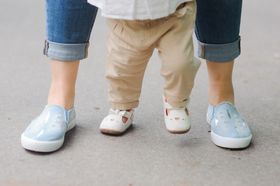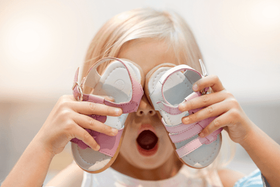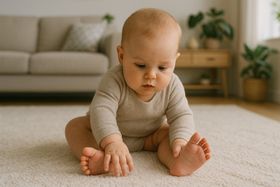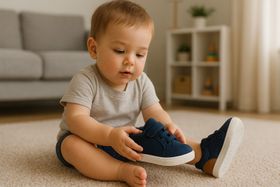Orthopaedic Shoes for Toddlers: Challenges & Benefits
Published November 30, 2024
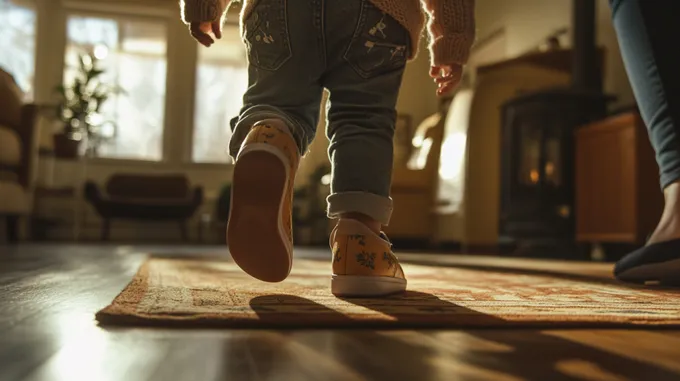
Full disclosure: your child's feet grow the fastest during their first three years.
Therefore, failing to invest in supportive footwear can result in various problems, from heel pain to foot defects. That said, the best orthopaedic shoes for toddlers can ensure the perfect fit and ultimately support healthy foot growth.
The Challenges of Toddler Shoes
Children need comfortable protection for their feet at the toddler age as they begin to walk for the first time. Granted, finding the right shoes is difficult when they face the following challenges.
Fast Growth
Firstly, because a toddler's feet grow in length and change shape too quickly, their shoes need to focus on function rather than fashion. They also need replacing more often. (We're talking around three to four times a year!)
Sure, babies and toddlers don't spend much time on their feet. However, this doesn't mean that their shoes fit correctly. The truth is, their shoes would rarely show signs of wear and tear.
Even so, it's essential to get your child's shoe size checked in line with these guidelines:
- Up to the age of three — every one to three months
- Up to the age of five — every four months
- From five years — every six months
You may also need to change their sock sizes accordingly.
Incorrect Fit
Allowing your toddler to wear shoes that no longer fit is worrisome. Why? Well, it can lead to more serious issues later on down the line.
Some signs that your baby desperately needs a new pair include:
- Limping
- Scuffs to the toes
- Blisters
- Your child refuses to put them on
Having a regular size check with a Fit Consultant expert can combat this, whether you're looking for flip flops or light-up sneakers.
- Other benefits of using a Fit Consultant expert are as follows:
- They understand children's foot anatomy, function, and structure
- Given that they work with children of all shapes and sizes, they have developed technical foot-measuring skills
- They can take the stress away from the parent
- Plus, they can suggest specific high quality, soft shoes for toddlers to match the activity and ensure their unique feet are taken care of.
Foot Problems
Foot problems in children mainly occur when there's an underlying injury, illness, deformity, or other heredity factors.
As a result, your little one may have muscle aches and problems, which means that they find walking tiring, difficult, or uncomfortable.
Improper footwear can aggravate pre-existing conditions. This is also why shoes should never be handed down, as tempting as it is to take them from your friends and family members with older kids.
Then there's a lack of arch development for those who are flat-footed. Children with flat feet (whether in both feet or just one foot) will experience tremendous pain.
In this case, you may need to call upon the help of a podiatrist. It is recommended by podiatrists to examine foot health frequently.
Heel Pain
Heel pain usually occurs in older children between the ages of eight and 14. However, sometimes it appears in their younger years.
You'll be able to tell if your toddler is suffering from this because they may limp or cry in pain when they're wearing their shoes.
Keep in mind that their shoes should fit comfortably around the heel. They shouldn't be too loose or tight.
If you suspect your mini-me is experiencing heel pain, a podiatrist can help further. They'll be able to determine if their case is related to the developmental process or a sign of something more serious.
Nail Injuries
Alongside foot injuries, neglecting to buy suitable shoes for toddlers in the correct fit can cause nail injuries, such as:
- Ingrown toenails
- Bruised toenails
- Toenails lifting from the nail bed
This can then result in pain and an inability for your child to go about their daily activities.
Severe nail injuries can also lead to an infection that may require antibiotics or minor surgery.
Usually, the culprit is footwear that:
- Isn't suitable for wide feet (which squashes the toes and forms ingrown nails)
- Is too small (so that the toes are crammed into the toe box and there's extreme pressure on the nails)
- Is too big (which means that the foot is moving around too much and the nails keep making contact with the end of the shoe, resulting in bruising and lifting)
As a rule of thumb, the top of the shoe should allow your kid's toes to move freely. Toes shouldn't be squashed from the sides or the top.
If there's approximately one centimeter of growing room between the end of the longest toe and the end of the shoe, they should be nice and snug without sliding off.
You may also need to consider investing in shoes for wide feet.
Corns and Hard Skin Build-Up
Corn or hard skin formation can reoccur as a protective mechanism if your child is having footwear problems.
This can then lead to extreme pain and discomfort. Typically, hard skin develops from shoes that are:
- Too big (so that the foot slips and slides around the shoe, which creates skin friction)
- Not wide enough (which can result in corn forming outside of the fifth toe due to the pressure of a shoe that's too narrow)
Sometimes, a few millimeters differentiate a shoe that fits well and a shoe that causes issues.
That's why it's so important to have your kid's feet measured for length and width. The shoe should fit the natural shape of their foot, especially around the toes.
The Benefits of Supportive Shoes for Toddlers
As soon as your little one starts taking their first steps, it's time to introduce them to their first pair of real shoes. And when it comes to toddler footwear, orthopaedic shoes are the way to go.
Unlike soft-soled baby shoes, orthopaedic shoes are specifically designed to support the delicate structure of a child's developing feet, ankles and legs. By providing proper support and cushioning, these shoes can help to:
- Prevent foot problems: Reduce the risk of common foot issues like flat feet, bunions, and ingrown toenails.
- Alleviate pain: Offer relief from discomfort caused by poor footwear choices.
- Promote healthy foot development: Encourage the natural growth and development of the foot's bones and muscles.
- Improve balance and coordination: Enhance your child's stability and overall motor skills.
Choosing the Right Orthopaedic Shoes
When selecting orthopaedic shoes for your toddler, consider the following factors:
- Fit: Ensure a snug fit without being too tight or too loose.
- Flexibility: The shoe should be flexible in the forefoot but sturdy in the heel.
- Support: Look for shoes with adequate arch support and a firm heel counter.
- Comfort: Choose soft, breathable materials that won't irritate your child's skin.
- Style: Opt for shoes that are both functional and fashionable.
By investing in high-quality orthopaedic shoes, you can give your child the best possible start in life. Remember, healthy feet are happy feet!
Tips for Styling
Just because orthopaedic shoes focus on practicality doesn't mean that they can't be stylish.
The best first shoes for toddlers will look good and feel good for a range of occasions.
Best for Casual Wear
High tops shoes for toddlers are ideal when paired with jeans and a t-shirt for casual wear. The Galactic Nichole sneaker offers extended ankle support, antibacterial insoles, and high built-in arch support for kids with flat feet.
Best for Cold Winter Months
For the winter months where a jumper and coat will also be needed, these Supreme Josh lace-up boots with extended tongue will do the job while making your child stand out for all the right reasons
Best for Play Time
The best play shoes for toddlers are sturdy yet allow maximum movement. Our Dylan The Brit printed sneakers or Rosalina Bloom closed-toe sandals are super cute but will let your little one jump around and climb as much as they like.
Best for Girls in Warm Summer Months
First Walkers have some of the best sandals for toddlers in Australia. These Arianna Florets printed blue and white shoes for girl toddlers are perfect for the summer months. Not only do they look pretty when paired with a cute dress or top and skirt, but they have three adjustable Velcro straps, air valves for moisture reduction, and are quick drying.
Best for Boys in Warm Summer Months
The best summer shoes for toddlers who are boys will be similar but include a darker colour or more masculine print. The Nigel the Harbor Boss style is perfect for those who love adventures just as much as they love the ocean! They have all the water-friendly and orthopaedic benefits of the Arianna Florets, including the Thomas heel.
The Takeaway
Toddler's feet are unique, delicate, and continuously developing.
Essentially, their footwear must be supportive and fit correctly so that they have the best chance of good foot health now — and in the years to come.
There's no better way to achieve this than with orthopaedic shoes for little girls or boys.
